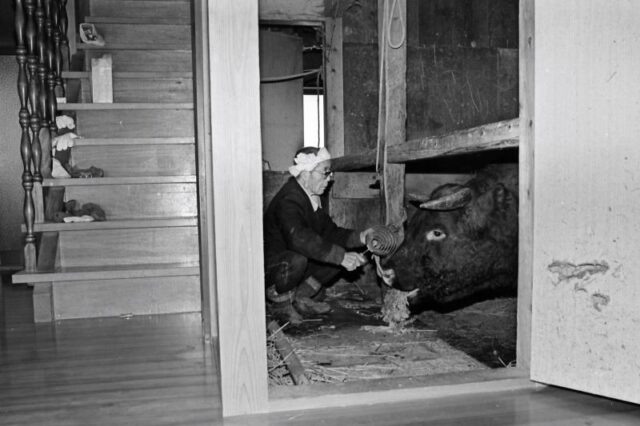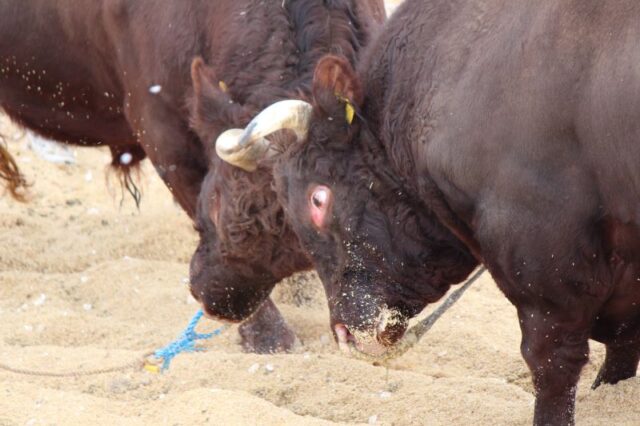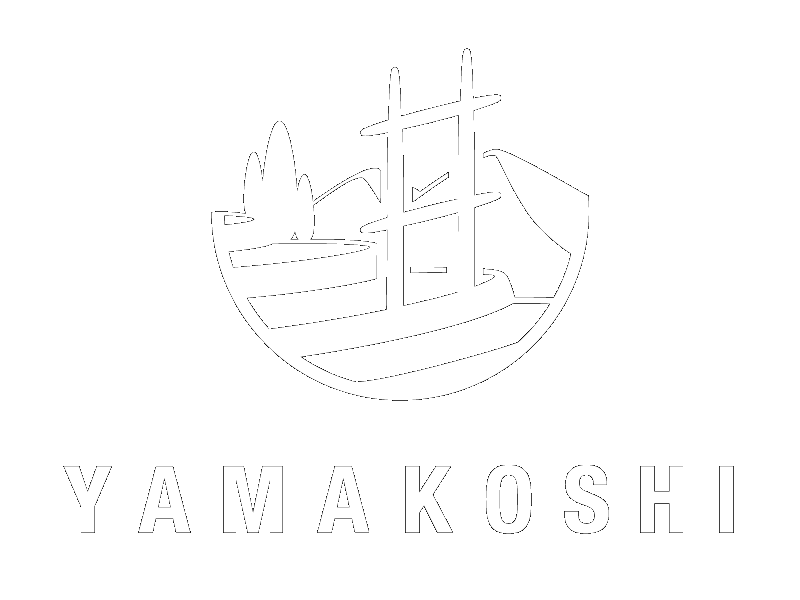
For the residents of Yamakoshi, the cow – specifically, cows – were indispensable partners in farming and transportation. For this reason, they built umaya (bull sheds) to keep cows penned in their thatched houses and live alongside them. The cows were like family members and were even called “oji”, a name for a younger brother in the local dialect; they were literally “those with whom they ate and slept together.”
Let’s trace the roots of “life with cows in Yamakoshi,” from the relationship between the people of Yamakoshi and cows to the culture of “bull sumo,” which has been registered as an Important Intangible Cultural Asset of Japan.
Life with Bulls

In the Yamakoshi region, people and cows were deeply connected.
In this rugged mountainous areas with little flat land, cows were obtained from other areas for fattening. There were two ways to obtain cows.
The first was to purchase livestock from bakuro (mainly from Aizu Wakamatsu) who specialized in buying livestock. The second was to borrow them for a season from farmers on the plains of Nagaoka and Kariwa. After helping with spring rice planting on the plains, farmers would take the cows back to Yamakoshi, care for them well, and return them to their owners around November. Historical documents in Yamakoshi say that the cows were returned to their owners well-fed, along with a monetary reward and rice.
According to a survey conducted in 1957, records from the Edo period show that of the 990 farm households in Yamakoshi, 4 horses and 370 cows were kept. Cows, which were strong on their feet and legs, were raised mainly for farming and transportation.
In agricultural work, cows pulled the manguwa (an agricultural tool similar to a plough) to level the soil in the rice paddies, trod across the bottom of the rice paddies to prevent the terraces from collapsing or leaking water, and played a major role in tilling this land with its many slopes.
They were also very useful as beasts of burden in mountainous areas where they had to cross steep passes, carry heavy loads and harvests between villages, both where people lived and in the forests, where production took place.
Cows also played a major role as livestock. In particular, manure from cow sheds was very valuable. The chemical fertilizers of the time were of poor quality, and in mountain communities where cash income and product distribution were difficult, cow manure was very useful as a fertilizer to supplement the soil in the fields.
Thus, it can be said that the living conditions in the mountainous area connected the daily life of Yamakoshi with cow breeding.
The “Bull Sumo” Ceremony, a local tradition with a history of 1,000 years

Designated as an Important Intangible Folk Cultural Asset, “Bull Sumo” has roots in Yamakoshi since ancient times as a Shinto ritual, with a history of more than 1,000 years. The most attractive point of the ceremony is that it maintains a culture in which there are no winners or losers in the competitions, so as not to hurt the cows, which were important family members and valuable workers for the farmers.
The two cows weighing more than one ton competing fiercely with each other with their horns locked in fierce battle of strength and skill with various techniques offers a gripping and heroic sight.
Just as the bout is about to be won, the captain of the bull team quickly raises his right hand, ending the match in a draw. The scene of the cows and the human participants engaging in a powerful battle of skills as they desperately try to control the raging cows, who still have a fighting spirit, is also a part of the “Bull Sumo” – and one of its most thrilling aspects.
The bullfighting of Yamakoshi is described in the Nanso Satomi Hakkenden, a masterpiece by Takizawa Bakin, a great writer of the Edo period (1603-1868). In the Hakkenden, the villagers of Yamakoshi are described in detail as they revere and enjoy Bull Sumo as a ritual, and the text includes the actual name of Mushikame village (Mushikame bullfighting arena) in the story.
“Bull Sumo,” which has been held as a Shinto ritual since ancient times, is sacred to the people of Yamakoshi, and there is a tradition that impure people are not allowed to go out to the Bull Sumo area. It can be said to be a place of respect for the cow who have supported mountain life as members of the family.
“Bull Sumo” After the Chuetsu Earthquake

On October 23. 2004, Yamakoshi was devastated by the Niigata Chuetsu Earthquake. The earthquake caused about half of the cows to be trapped under collapsed barns, and about half of the cows lost their lives in an instant.
As a result of this tragedy, though the owners and their children felt as if they were losing their own lives, they were forced to follow the order to evacuate the entire village, leaving their cow behind. A few days after the evacuation, with aftershocks still continuing, they returned to the village to rescue the remaining cows, risking everything to return them to safety, and spent three days bringing the cows down the collapsed slopes.
After that, both the cows and the residents were forced to live in temporary housing and barns. As a stepping stone toward reconstruction, a temporary bullfighting arena was built in May 2005 and “Bull Sumo” resumed. The event was a great success, with as many as 3,000 people from inside and outside of the prefecture coming to watch in support of Yamakoshi’s recovery. The “Bull Sumo” became a symbol of hope for the people affected by the earthquake.
Although the very existence of Yamakoshi’s “Bull Sumo” tradition was threatened for a time by a major earthquake, the first bullfighting tournament was held at the Yamakoshi Bullring in 2008 after only a four-year recovery period. This was made possible by the passion of the bullfighters and local residents who loved cows and wanted to preserve the tradition, as well as by the warm support from all over Japan.
The “Bull Sumo” is still held once or twice a month starting from the first tournament on May 4 and ending on November 3, and is supported by many fans as the traditional ritual of Yamakoshi.
